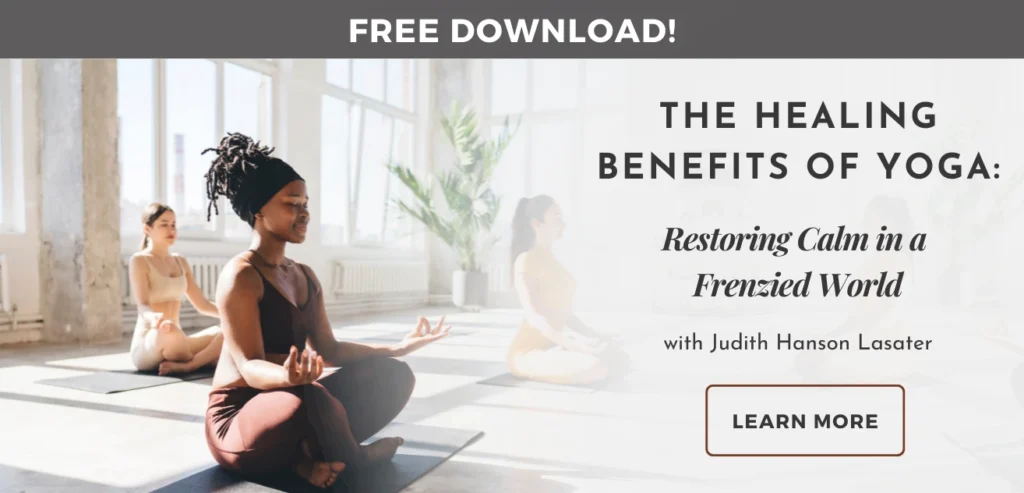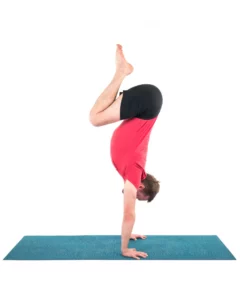Dhanurasana (Bow Pose) with a Yoga Strap Bowstring

Years ago, I heard Judith Hanson Lasater pose this question: “Who should practice backbends?” Her answer: “Anyone who’s growing older.” This, of course, means everyone. Most of us spend our days bent over one thing or another—desks, electronic devices, counters, etc. Moving our shoulder joints and spines in the opposite direction counters the tendency to hunch forward. The Hatha Yoga Pradipika, the traditional text that describes the 15 poses that have endured through the millennia, includes only one backbend as essential to asana practice: Bow Pose (Dhanurasana).
When Britain colonized India, they imported British gymnastics to the country, and, specifically, to the practice of yoga. So most of yoga’s backbends actually came from the colonizers. That doesn’t mean these imported backbends are not helpful for our bodies, however. In fact, the range of backbends in the current asana canon ensures that there will be at least one backbend to fit every person’s structure.
THE BENEFITS OF BACKBENDING
Backbending confers multiple benefits:
- Strengthening the muscles that extend the spine to help us maintain a healthy, upright posture
- Expanding the chest and anterior shoulder joints
- Stretching the abdominal muscles
- Lengthening the hip flexors, muscles that tend to shorten when we spend long hours sitting
- Revitalizing the body in general, backbends tend to heat and energize our bodies and minds
DHANURASANA CHALLENGES AND SOLUTIONS

There’s no doubt that backbends can be challenging. Some people’s structures are made for backbends; others, not so much. We can prep our bodies for backbending, but for some people, a more stable spinal structure will limit how far their bodies will go. The extent to which your lumbar spine will extend is one determining factor. People with a curvier thoracic spine might also find some backbends more challenging. But this is all entirely okay. No matter how “deep” your backbends look, anyone can enjoy the benefits.
Dhanurasana can be challenging for people with any of the aforementioned structural qualities. But it’s also easy to modify, using a yoga strap to connect your hands with your feet.
HOW TO PRACTICE DHANURASANA WITH A YOGA STRAP
Photo courtesy of Hugger Mugger Yoga Products
- Gather your props: yoga mat, yoga strap and a firm blanket (optional). If your hip bones are sensitive to pressure, you might want to place a folded blanket across the center of your mat.
- Lie face down on your mat, with your pelvis on your folded blanket if using.
- This is the tricky part: Bend your knees, drawing your heels in close to your glutes. Loop the strap around your ankles and hold onto the ends of the strap, one in each hand. Flex your ankles to keep the strap from sliding off your feet. Hold the strap taut enough so that it doesn’t slide down your legs toward your knees. Of course, you can avoid this awkward move by having a friend or teacher place the strap around your ankles if you’re not practicing alone.
- Lie face down again, but with your knees bent and the strap ends in both hands.
- Root your pelvis into the floor and lift your chest and legs, walking your hands toward your feet to keep the strap taut.
- Keep your head in a neutral position, facing straight ahead. There’s a tendency to throw your head back in backbends, but in prone backbends in particular, this can strain your lumbar spine. This is because when your neck is hyperextended, your hyoid bone pushes forward and disengages your digestive organs. You can read more about this here.
- Stay in the pose for 5 to 10 deep breaths. When you’re finished, return to a prone position. If you want to practice Dhanurasana again, keep ahold of the strap. If not, let go and relax with your head resting on your hands.
Also, read...
Desk-Friendly Yoga Neck and Shoulder Stretches
6 Yoga Poses to Expand Your Heart
Yoga Practice Tips: Why Listening to Your Body Might Not Be Enough
Related courses

Charlotte Bell began practicing yoga in 1982 and began teaching in 1986. She was certified by B.K.S. Iyengar in 1989 following a trip to Pune. In 1986, she began practicing Insight Meditation with her mentors Pujari and Abhilasha Keays. Her asana classes blend mindfulness with physical movement. Charlotte writes a column for Catalyst Magazine and serves as editor for Yoga U Online. She is the author of two books: Mindful Yoga, Mindful Life, and Yoga for Meditators, both published by Rodmell Press. She also edits Hugger Mugger Yoga Products’ blog and is a founding board member for GreenTREE Yoga, a non-profit that brings yoga to underserved populations. A lifelong musician, she plays oboe and English horn in the Salt Lake Symphony and the folk sextet Red Rock Rondo whose 2010 PBS music special won two Emmys.




